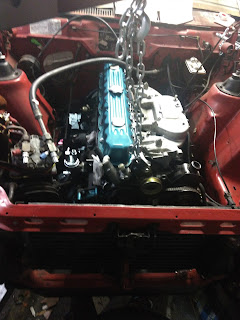The majority of my time lately has been split between searching for odd jobs to bring in some additional income and waiting for FedEx. See, while I put far too much time into jig making, I neglected to apply the same thoroughness to confirming the numbers for my measurements were accurately transcribed. This is diplomatic wording for "I didn't pay enough damn attention and fucked up the backup driveshaft."
So with that, the hunt for an appropriate replacement began. This is what we ended up with:
It's a quarter inch longer than the stock driveshaft, which should be within the amount of play my slip yoke can provide. If you're wondering why it's not installed yet: it was delivered yesterday while I was fighting against throttle valve linkage issues that Eagle was having (luckily, this was remedied by switching out and repositioning my throttle return spring). Oh, and also, my flexplate is cracked.
I have no idea who or what managed to do this, but I've not done anything that would cause this to happen. Luckily, the Sportabout provides once more and I've got the plate that came with the transmission. As to the best of my knowledge, it looks to be a plate for the 258/232, and not the 304. While some online stores say they'll work across the board, I'm really skeptical because the 304 wasn't internally balanced like the I6s. I doubt that they swap out just fine, and a number of AMC greybeards are adamant that my suspicions are correct, so I'm going to take their word for it.
So given that the flexplate is cracked, the trans is in the process of being decoupled as I type this. I'll do a strict comparison once it's out, and that'll determine whether the Sportabout plate goes in or if I'm waiting for FedEx again. Thankfully, should a new plate be needed, I can get one for under $40.
Once that's done, I'll need to get back to doing the ujoints I'd started on, as the ones that came with the replacement shaft are of a different type (and the rattlecan spray isn't really confidence-inspiring).
Not thrilled about having to get conversion joints, but I'm not sending a ton of power or an unreasonable amount of torque through them, nor do I intend to take this car on the trail (at least until the day comes where I convert it into something along the lines of an Eagle kammback). That said, I'm sure they'll do fine.
Lastly, in honor of the donor Sportabout I never met, here's a picture of a local Sportabout I've been trying to catch standing still for a couple years. It's a '75 with a 304, and appears to have formerly been a city government vehicle. The owner says he drives it constantly and has had it for over 20 years. While his enthusiasm for his wagon seemed not to match mine, there's gotta be some love for it to be kept going for this long. You can see Eagle creeping around in the upper left corner.
Alright, that's enough fucking around. I'll let y'all know how things turn out when they get where they're going.




















